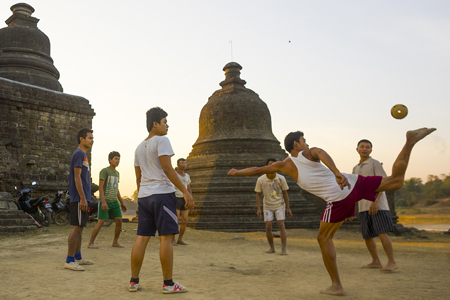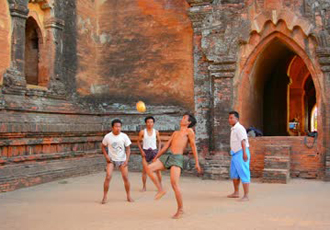Chinlon, or cane ball, is a traditional sport of beautiful Myanmar that has been co-existed with the locals since the time immemorial. It is known as a game more than a normal sport in which a four-inch cane ball is tossed and kicked around by a good player or a team of players in the circle. It has gone through a long time that becomes the national game of Myanmar that practiced by men, women, and children throughout the country. For the entertaining and fluid, Chinlon is an interesting sport of Myanmar that will excite tourists’senses if they have a chance to witness the performance once in Burma tours.
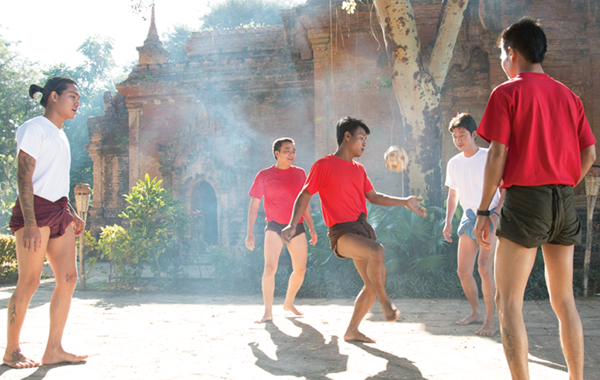
The History of Chinlon – The Traditional Sport of Myanmar
The history of Chinlon began for about 1500 years. At first, Chinlon is created as a means of entertaining Burmese royalty. It is heavily influenced by the traditional art and dance of Burmese and thus that is the reason why we call it: a combination of sport and dance.
From the time Myanmar gained independence from the British in 1948, Myanmar has been influenced significantly by colonial architecture, culture. It was not until 1960 that the government of Myanmar decided to the necessary of the country’s traditions that unique to the culture of the country. Chinlon fit this requirement perfectly. As a result, it was played as a real sport to aim at keeping Myanmar nationalism.
Nowadays, Chinlon is played in every part of the country in daily and festival. It is a way of entertaining after a long day of working and studying. Besides, it is also practiced as physical education in schools as a way to educate children about the culture of Myanmar.
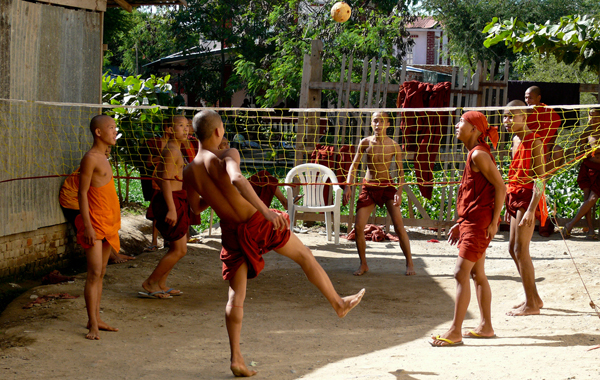
How To Play Chinlon Game
Due to the material used to make Chinlon (cane or rattan) is profuse in many forests of Myanmar, very light, resilient but long-lasting chinlons are cheap and easily available at any village stall.
Chilon traditionally is considered as the men’s daily pastime. Myanmar people played Chilon as a way to do exercise when the back and limbs got cramped due to sitting, working and standing for too long. Since the aftermath of the war, both men and women could play it. While playing this sport, they normally wear shorts and canvas shoes. While chinlon playing provides men with a good chance to show off their masculine physical beauty, especially if their body, hands, and chest are well tattooed, women play chinlon to display feminine body elasticity and skills in playing it.
Foreigners consider chinlon as Myanmar football as people use many parts of their body except for their hands to toss, kick and keep the ball in the air as long as possible. However, unlike soccer, there is no formal scoring and no goal to shoot in chinlon playing and no fixed number of players. This game can be played by any number of players, from 3 to 10 players forming a circle and avoid the cane-ball falling on earth. All age groups play this game joyfully, mostly in rural and suburban areas. Some virtuoso in this art can display her extraordinary talent for tossing and keeping the ball for a very long time, and showing different kicking styles, sometimes combining with using cane rings at the same time.
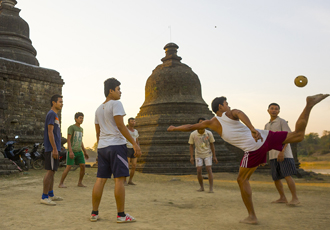
Chinlon playing is usually accompanied by music at festivals. A band of percussion and wind instrumentalists continuously play while the chinlon play is on. The music changes its tempo in harmony with the movements of chinlon and players. A skillful player can play with four to eight chinlons using all possible tactics to keep them on or around his or her body.
Foreigners are usually in awe and applaud while watching a person standing on one leg all the time, taking every possible posture and movement to keep the chinlon in the air or to prevent it from touching the ground. Chilon requires the players to make a number of endeavors to toss, kick and bounce.
No one could know exactly when chinlon playing emerged in Myanmar. But this kind of sport has become an indispensable part of the locals’ lives and exists deeply in their heart.
See the video of Myanmar Waso Chilon Festival

